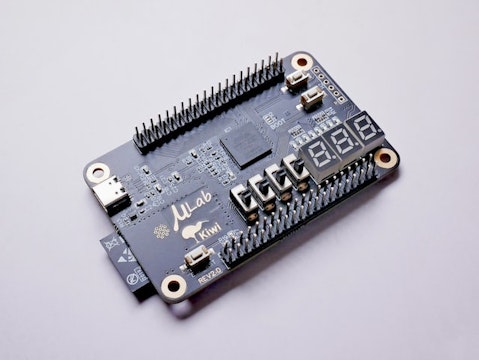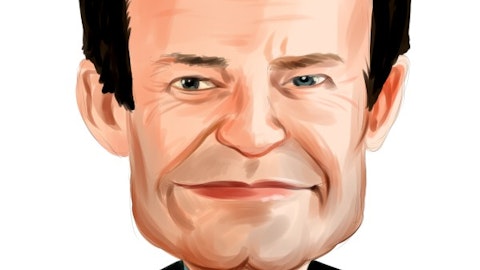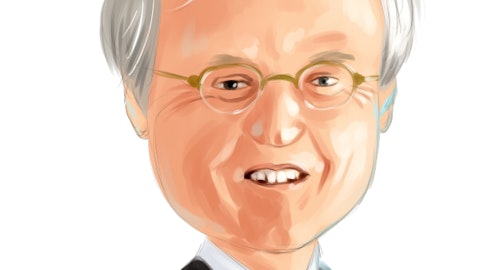Plexus Corp. (NASDAQ:PLXS) Q1 2023 Earnings Call Transcript January 26, 2023
Operator: Good morning, and welcome to the Plexus Corp. conference call regarding its fiscal first quarter 2023 earnings announcement. My name is Liz, and I will be your operator for today’s call. . I would now like to turn the call over to Mr. Shawn Harrison, Plexus’ Vice President of Communications and Investor Relations. Shawn?
Shawn Harrison: Thank you, Liz. Good morning, everyone, and thank you for joining us today. Some of the statements made and information provided during our call today will be forward-looking statements, including, without limitation, those regarding revenue, gross margin, selling and administrative expense, operating margin, other income and expense, taxes, cash cycle, capital allocation and future business outlook. Forward-looking statements are not guarantees, since there are inherent difficulties in predicting future results, and actual results could differ materially from those expressed or implied in the forward-looking statements. For a list of factors that could cause actual results to differ materially from those discussed, please refer to the company’s periodic SEC filings, particularly the risk factors in our Form 10-K filing for the fiscal year ended October 1, 2022, and the Safe Harbor and fair disclosure statement in yesterday’s press release.
We encourage participants on the call this morning to access the live webcast and supporting materials at Plexus’ website, www.plexus.com, clicking on Investors at the top of that page. Joining me today are Todd Kelsey, Chief Executive Officer; Steve Frisch, President and Chief Strategy Officer; Pat Jermain, Executive Vice President and Chief Financial Officer; and Oliver Mihm, Executive Vice President and Chief Operating Officer. Consistent with prior earnings calls, Todd will provide summary comments before turning the call over to Steve and Pat for further details. Let me now turn the call over to Todd Kelsey. Todd?
Todd Kelsey: Thank you, Shawn. Good morning, everyone. Please advance to Slide 3. Our fiscal 2023 started strong, as we capitalized on the momentum built during fiscal 2022. As I reflect on the market conditions and supply chain dynamics of 12 months ago, I’m quite pleased with our performance in the fiscal first quarter. Amid unexpected demand volatility, we met our guidance and delivered 34% year-over-year revenue growth, generated an industry-leading GAAP operating margin, and nearly doubled our GAAP earnings per share year-over-year. We also advanced our efforts to be an ESG leader, an endeavor that our customers are taking notice. Our fiscal first quarter revenue of $1.09 billion, reflected strong demand from many customers, even as we experienced unexpected volatility from others.
Semiconductor capital equipment demand was lower than our customers anticipated 90 days ago due to weakness in the memory market, paired with the effects from the US export control order. In addition, we experienced new program ramp schedule changes, a dynamic that is expected to be resolved as we move through fiscal 2023. Finally, we continued to have unfulfilled demand by more than $100 million, given ongoing supply chain challenges associated with lagging edge semiconductors. I would note that our average semiconductor lead time declined only 4% from last quarter, and remains in excess of 300 days. We delivered GAAP operating margin of 5.2%, inclusive of stock-based compensation expense and the cost associated with the ramp up business at our new facility in Bangkok, Thailand.
With strong customer interest, we continue to anticipate our operations in Bangkok will be profitable exiting this fiscal year. Finally, we delivered GAAP EPS of $1.49, which included $0.21 of stock-based compensation expense. We won 29 new manufacturing programs during the quarter worth $158 million, including several programs associated with secular growth markets. As we discussed in recent quarters, supply chain conditions continue to slow the decision-making process for some customers that we anticipate will partner with Plexus. However, we see this trend reversing during our fiscal second quarter, driving increased wins for the remainder of the fiscal year. Our funnel of qualified manufacturing opportunities expanded nearly $250 million sequentially to a record $3.6 billion, reflecting the delayed decision-making and significant potential to increase our wins.
Please advance the Slide 4. We continued to demonstrate our commitment to be a leader in environmental, social, and governance, through how we innovate and operate. Late last year, we joined the Semiconductor Climate Consortium as a founding member, partnering with many of our SemiCap customers and industry-leading technology firms that are focused on accelerating the reduction of greenhouse gas emissions throughout the semiconductor value stream. In addition, we received ASM International’s PRISM Award For Supply Chain Sustainability Innovation. The award was given as a result of our global internal competition called BEST, which fosters team member innovation and continuous improvement. This competition has highlighted ESG initiatives such as smart metering, water usage reduction, and implementation of alternative energy sources, all of which are helping to reduce our environmental impact.
We are proud that our efforts were recognized by an important customer and SemiCap industry leader. Please advance to Slide 5. We are guiding fiscal second quarter revenue of $1.02 billion to $1.07 billion, GAAP operating margin of 4.5% to 5%, inclusive of approximately 60 basis points of stock-based compensation expense, and GAAP EPS of $1.06 to $1.24, inclusive of $0.21 of stock-based compensation expense. Our guidance reflects the continuing impact of the near-term demand dynamics that affected our fiscal first quarter, including weakness in SemiCap demand, a near-term slowdown in certain new program ramps, and well in excess of $100 million of unfulfilled customer demand. Our operating margin guidance reflects reduced fixed and administrative cost leverage, coupled with our typical seasonal cost increases associated with merit-based salary adjustments, and US payroll tax resets.
We expect to overcome both as we move through fiscal 2023. Finally, our fiscal second quarter EPS guide is impacted by higher interest expense and tax expense compared to our fiscal first quarter. I continue to see the potential for strong performance in fiscal 2023 and beyond. While recognizing macroeconomic and geopolitical uncertainties, we have the opportunity to deliver industry-leading profitability and revenue growth rates significantly in excess of the markets we serve. We expect to return to quarterly sequential revenue growth beginning in our fiscal second half associated with robust Healthcare/Life Sciences and Aerospace and Defense market sector demand, normalizing existing program ramp schedules, additional new program ramps as we benefit from share gains, and participation in secular growth markets, and continued backlog conversion, given our focus on resolving supply chain challenges.
In looking at our end markets for fiscal 2023, our Healthcare/Life Sciences market sector is poised to have a tremendous year. The sector is benefiting from a sustained recovery and demand for elective procedures, numerous new program ramps that have yet to reach steady state, and our continued efforts to mitigate supply chain challenges. We see the opportunity for healthy growth from our Industrial sector due to our participation in secular growth markets such as warehouse and factory automation, our continued efforts to clear supply chain challenges, and new program ramps in developing markets such as electrification. While supply chain demand – or while SemiCap demand is much weaker than 90 days ago, we continue to anticipate we’ll outperform the market, given share gains and new program ramps.
Finally, demand from our Aerospace and Defense market sector continues to recover, particularly in commercial aerospace. Supply has been the gating factor for several quarters now, but our progress in resolving those challenges, provides the potential for sequential revenue growth throughout the remainder of fiscal 2023, resulting in robust sector growth for the fiscal year. With the anticipated return of sequential revenue growth for our fiscal second half, we are focused on achieving our 5.5% GAAP operating margin goal exiting the fiscal year. I will now turn the call over to Steve for additional analysis of the performance of our market sectors and operations. Steve?
Steve Frisch: Thank you, Todd. Good morning. I will start on Slide 6, with a review of the fiscal first quarter performance of our market sectors, as well as our expectations for the sectors for the fiscal second quarter of 2023. Starting with the Industrial sector, revenue declined by 9% in the fiscal first quarter. The result was lower than our expectation of a mid-single-digit decline. Although we anticipated forecast reductions from our SemiCap customers as we started the fiscal first quarter, almost all of the SemiCap customers’ adjusted demand lowered during the quarter due to softening end markets and the impact of the recent export control order from the US Department of Commerce. For the fiscal second quarter, the export control order and the softness in the memory market, is pressuring demand in the SemiCap sub-sector.

Photo by Vishnu Mohanan on Unsplash
As a result, we are forecasting approximately a 10% decline in the Industrial sector for the fiscal second quarter. As we look to the second half of fiscal 2023, we expect sequential growth in the Industrial sector, as new program ramps within the sector start to materialize. On top of the exceptional growth of 17% in the fiscal fourth quarter of 2022, our Healthcare/Life Sciences sector grew an additional 4% in the fiscal first quarter. The result was in line with our expectation of a mid-single-digit increase. Contributions from new program ramps supported the growth. As we start the fiscal second quarter, we are working with our customers to implement engineering changes on active program ramps. The short-term impact is that we expect our Healthcare/Life Sciences revenue to be flat for the fiscal second quarter, before the sector returns to healthy sequential growth in the fiscal third quarter.
Our Aerospace and Defense sector declined 2% in the fiscal first quarter. The result was in line with our expectations of a low single-digit decrease. Improved shipments for several customers could not offset the revenue headwinds from the end of life program we highlighted last quarter. Although fulfillment of our customers’ overall demand is still hampered by supply chain constraints, our procurement team has made meaningful progress. As such, we anticipate a low single-digit increase in the Aerospace and Defense sector for the fiscal second quarter. We believe our ability to fulfill demand will continue to improve throughout fiscal 2023. Please advance the Slide 7 for an overview of our wins performance. We won 29 new manufacturing programs during the fiscal first quarter that we expect to generate $158 million in annualized revenue when fully ramped into production.
Although the result was below our expectation, we believe that near-term macroeconomic and geopolitical uncertainties are extending decision-making cycles. We highlighted this view in our previous earnings calls, and as we exit the fiscal first quarter, our funnel of qualified opportunities illustrates this dynamic. As shown on Slide 8, our robust funnel of qualified manufacturing opportunities jumped by nearly $250 million to $3.6 billion in the fiscal first quarter, easily surpassing the record levels of fiscal 2023. As we look at the metrics within the funnel, our program win rates continue to be high, and cancellations of programs within the funnel remain normal. Based upon current visibility into the funnel, we anticipate a noticeable rebound in our new program wins in the fiscal second quarter.
Going back to the fiscal first quarter manufacturing wins, Slide 9 has a few sector and region highlights. The wins were spread across the sectors. Our Industrial sector won 14 new programs, including two new logos valued at $74 million. Our Healthcare/Life Sciences sector won nine new programs, including one new logo valued at $61 million. And our Aerospace and Defense sector won $23 million in new programs. Wins for the EMEA region were exceptionally strong for the third quarter in a row. With the additional $93 million in wins in the fiscal first quarter, the region is poised for significant growth. I’ll provide insight into some of their recent wins next. Please advance to Slide 10 for highlights of the fiscal first quarter wins. I’ll start with two significant wins from our Industrial sector.
The first product is used in factory automation and process control. We expect to start ramping this program from a new logo into our Oradea, Romania facility by the end of this fiscal year. The second Industrial sector win is a next-generation 3D printer from a current customer. This new additive manufacturing system will join the family of products already manufactured by our team in Appleton, Wisconsin. Our Healthcare/Life Sciences team expanded our market share with a customer who produces infusion pumps. This takeaway from a competitor was a direct result of our Oradea manufacturing team’s exceptional performance for this customer during the pandemic. The Healthcare/Life Sciences team also won an ultrasound system used for cardiac care.
This product will also be produced by our team in Oradea, Romania. Finally, our Aerospace and Defense wins include the brake controller for commercial aircraft. This program will be added to the platform of products we build for this customer in Neenah, Wisconsin. Next, I would like to turn to operating performance on Slide 11. During our fiscal first quarter, our team experienced demand volatility in SemiCap customer forecast, continued challenges in securing supply of lagging edge semiconductors, and engineering changes within process new program ramps. In spite of these challenges, they delivered strong GAAP operating margin performance of 5.2%. These challenges, combined with seasonal impacts, are putting short-term pressure on operating margin in the fiscal second quarter.
As we look beyond the current quarter, we see the potential for fiscal 2023 revenue growth that exceeds our 9% to 12% annual target. With an unfulfilled backlog of more than $100 million, stabilizing customer forecasts, new program ramps, and continued action to improve supply constraints, the team is focused on delivering the revenue potential, while achieving 5.5% GAAP operating margin as we exit fiscal 2023. I will now turn the call to Pat for an in-depth review of our financial performance. Pat?
Pat Jermain: Thank you, Steve, and good morning, everyone. Our fiscal first quarter results are summarized on Slide 12. Gross margin of 9.3% was at the midpoint of our guidance and slightly below last quarter, due to ongoing investments and fixed costs, including our new Thailand facility. Selling and administrative expense of $44 million was favorable to guidance, primarily due to lower incentive compensation expense. As a percentage of revenue, SG&A was 4%, which was consistent with expectations. GAAP operating margin of 5.2% was also at the midpoint of our guidance, and included 53 basis points of stock-based compensation expense. Non-operating expenses were favorable to expectations as a result of additional interest income and lower factoring fees due to a near-term reduction in receivables factored.
GAAP diluted EPS of $1.49, met the midpoint of our guidance for the reasons previously mentioned. Turning to our cash flow and balance sheet on Slide 13, as anticipated, for the fiscal first quarter, we made investments in working capital to align with our customers’ demand. Cash investments in operations totaled $49 million, while capital expenditures totaled $23 million. During the quarter, we purchased approximately 116,000 shares of our stock for $11.5 million at an average price of $99.12 per share. We have approximately $35 million available under the current $50 million authorization, and expect to execute repurchases on a consistent basis throughout fiscal 2023. With a strong and liquid balance sheet, investments in operations and our share repurchase program, were funded through a combination of cash and borrowing under our revolving credit facility.
Our quarter end balance sheet included cash of $248 million and debt of $516 million. At the end of the quarter, we had $180 million available to borrow under our credit facility. For our fiscal first quarter, we delivered return on invested capital of 13.8%, which was 480 basis points above our weighted average cost of capital. Strong operating performance this quarter, compared to the prior year fiscal first quarter, led to an improvement in ROIC of 380 basis points. During the fiscal first quarter, we experienced an increase in working capital requirements, which led to cash cycle days above expectations and sequentially higher by six days. Please turn to Slide 14 for more details on our cash cycle. Sequentially, gross inventory dollars increased by less than 3%, while inventory days increased by seven.
The increase in days resulted from strategic investments to support new program ramps and the impact on inventory from demand volatility within the quarter. Partially offsetting the increase in inventory days was a four-day increase in customer deposit days. We now have over 30% of our gross inventory covered with cash deposits. This compares to less than 15% four years ago. Accounts payable days sequentially reduced by three days related to earlier procurement of inventory and customer demand fluctuations. As Todd has already provided the revenue and EPS guidance for the fiscal second quarter, I’ll review some additional details, which are summarized on Slide 15. Fiscal second quarter gross margin is expected to be in the range of 8.8% to 9.2%.
At the midpoint, gross margin would be approximately 30 basis points lower than the fiscal first quarter. Seasonal compensation cost increases, as well as the reset of payroll taxes for US employees, will negatively impact gross margin by approximately 50 basis points. We expect selling and administrative expenses in the range of $44.5 million to $45.5 million, sequentially higher primarily due to the seasonal compensation headwinds, which total about $1 million. Non-operating expenses are expected to be in the range of $10.2 million to $10.7 million, sequentially higher, primarily due to increased borrowing under our revolving credit facility, along with the impact of rising interest rates. Our tax rate for the fiscal second quarter is expected to be in the range of 15% to 17%, while the full year tax rate is projected at 14$ to 16%.
Our expectation for the balance sheet is that working capital investments will modestly increase compared to the fiscal first quarter. Based on our revenue forecast, which has been impacted by near-term demand volatility, we expect cash cycle days in the range of 110 to 115 days. With modest working capital investments, coupled with capital expenditures to support anticipated fiscal 2023 revenue growth, we expect breakeven to a slight usage of cash for the fiscal second quarter. A few comments on the full year. We continue to expect capital spending in the range of $110 million to $130 million, and plan for free cash flow to improve as we move through fiscal 2023, targeting to end the year with close to $50 million of free cash flow. With that, Liz, let’s now open the call for question.
See also 13 Largest Gold Mines in the World and 25 Strongest Countries in Europe by Military Power.
Q&A Session
Follow Plexus Corp (NASDAQ:PLXS)
Follow Plexus Corp (NASDAQ:PLXS)
Operator: . Our first question comes from Jim Ricchiuti with Needham. Your line is now open.
Jim Ricchiuti: Hi. Good morning. I was hoping to get some additional color on the schedule changes you alluded to with some of these program ramps. And you may have elaborated that. I may have just missed it, but I wonder if you could talk in terms of the market verticals where you’re seeing this, and whether this is something that you see as company-specific, or potentially just a reflection of the more uncertain macro environment. Thank you.
Todd Kelsey: Yes, Jim, so this is Todd. I’ll start out with this question, but if we think about program ramps in general, it’s common for them to be a bit lumpy in the way that they progress over time. And if you recall back to a year ago when we started to talk about this small number of very large program ramps that we had underway, we talked about it, or I talked about it being in the range of $25 million to $50 million of sequential growth per quarter. And the reason for that range, part of it is because you can expect that there could be changes to the product as you go through this. So, and if you recall our results, we ended up overshooting the high end on this, so they were progressing extremely well, and now it’s paused, I would call it just a bit, not that the ramps have stopped.
They’ve just slowed a bit as a result of some changes that need to be made on the engineering front within the program. So, nothing out of the ordinary, other than perhaps it happened a bit later than we had anticipated when we were looking at this, but the programs still have a great potential and will continue to ramp aggressively and I’d expect as we – we’ll be moving ahead, at least on a good portion of that through our fiscal second quarter as we exit it, and then through the remainder of fiscal 2023.
Jim Ricchiuti: Is there a way to think about this in terms of the number of programs? I’m curious how spread out this is among different customers or different ramps, specific.
Todd Kelsey: It’s a small number of significant programs. So, that’s the reason for the impact. So, I’d call it – it’s not market dynamics. It’s essentially product dynamics that we have right now, and you can see that at least – from Steve’s commentary, that at least some of it impacts our healthcare sector, and that’s why it’s flat this quarter rather than continued sequential growth because they’re on a tear right now.
Jim Ricchiuti: Okay. And one final question, and I’ll jump back in the queue. I’m not sure how to – what to make of what you’re seeing in terms of supply chain. It sounds like it’s getting a little better, but it’s still, yes, pretty significant headwind for you. As you think about the sequential improvement that you’re anticipating in this second half, what are some of the assumptions that you’re making with respect to some of the supply chain challenges?
Todd Kelsey: Yes, I would say that we’re assuming it stays about the same. So, one of the things, though, that we’d anticipate is within Aerospace and Defense, we’d continue to clear more supply challenges in aerospace, because it’s getting – if you recall, our other demand from our other sectors, it ramped faster, the demand curve. So, we were able to clear a significant amount of that demand in the late fiscal 2022 timeframe. Aerospace and Defense was about a half a year to three quarters of a year behind in the demand increasing. So, we’re getting to the point where we expect we’ll be able to be clear in some of those challenges, but we don’t expect the supply chain to change meaningfully.





